| Srl | Item |
| 1 |
ID:
107644


|
|
|
|
|
| Publication |
2011.
|
| Summary/Abstract |
In 1989, the term fatwa became globally known, following Ayatollah Khomeini's death-fatwa issued on Salman Rushdie for his novel, Satanic Verses. Today, the Internet has become a useful platform for posting of fatwas and interpretations of fatwas. The present article highlights the use of jihadist fatwas, and especially online fatwas, as a major instrument in bridging the current wave of terrorism and religion. The analysis, based on a database collected in a 12-year-long project of monitoring thousands of terrorist websites, illustrates how cyber-fatwas are related to key issues in promoting terrorism: justifying the use of suicide terrorism, the killing of innocents, the killing of children and women, the killing of Muslims or the use of various weapons (including weapons of mass destruction and cyberterrorism). There are two implications of the trends documented in this study: First, the analysis of the online fatwas and the fatwa wars may provide insight about the terrorists, their motivations, their doubts and fears and, secondly, it may guide countercampaigns.
|
|
|
|
|
|
|
|
|
|
|
|
|
|
|
|
| 2 |
ID:
094844


|
|
|
|
|
| Publication |
2010.
|
| Summary/Abstract |
Given the growth of Internet research in recent years, it is rather surprising that research of online terrorism and countermeasures has been lacking theoretical and conceptual frameworks. The present study suggests applying the concepts and models taken from e-marketing to the study of terrorist websites. This work proves that when Hamas builds an array of sites in the Internet, it complies with the same rules that the Western business world follows. Chaffey et al. (2000) constructed a model comprised of eight decision points in the process of building a business-oriented Internet site. Although the model was developed for commercial purposes, the present study demonstrates how it could be used as an analytic framework to study terrorist websites. As shown, most of the decision points in the model were relevant to the Palestinian Information Center group of websites. Understanding the e-marketing strategy of Hamas will allow the construction of a competing marketing strategy in order to market rival ideological consumer products.
|
|
|
|
|
|
|
|
|
|
|
|
|
|
|
|